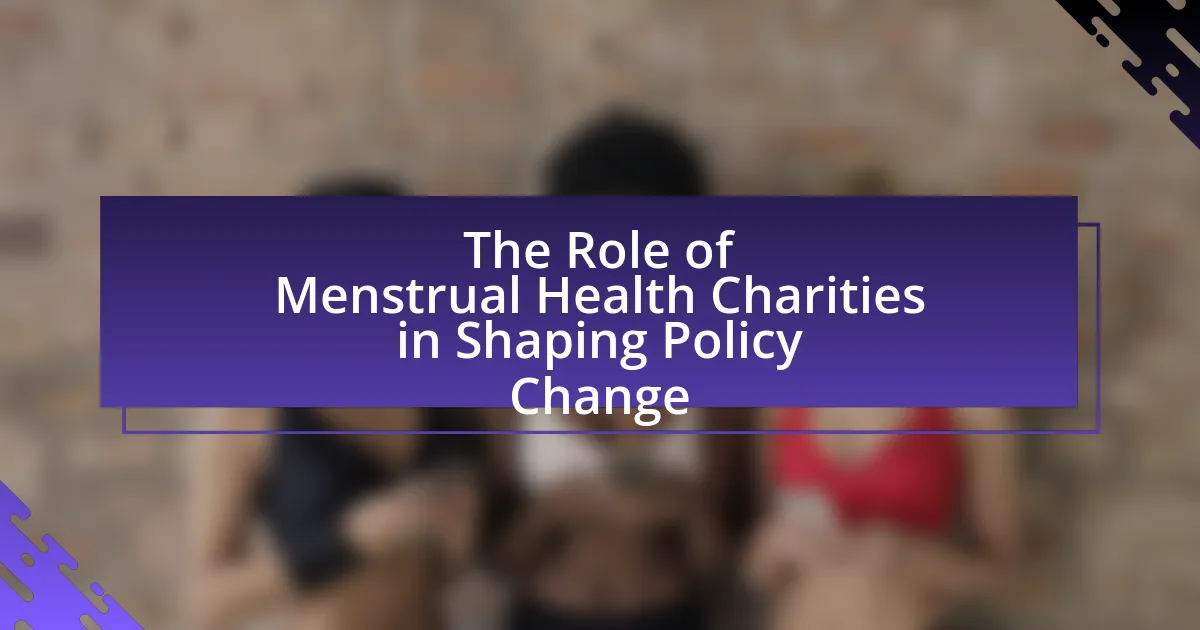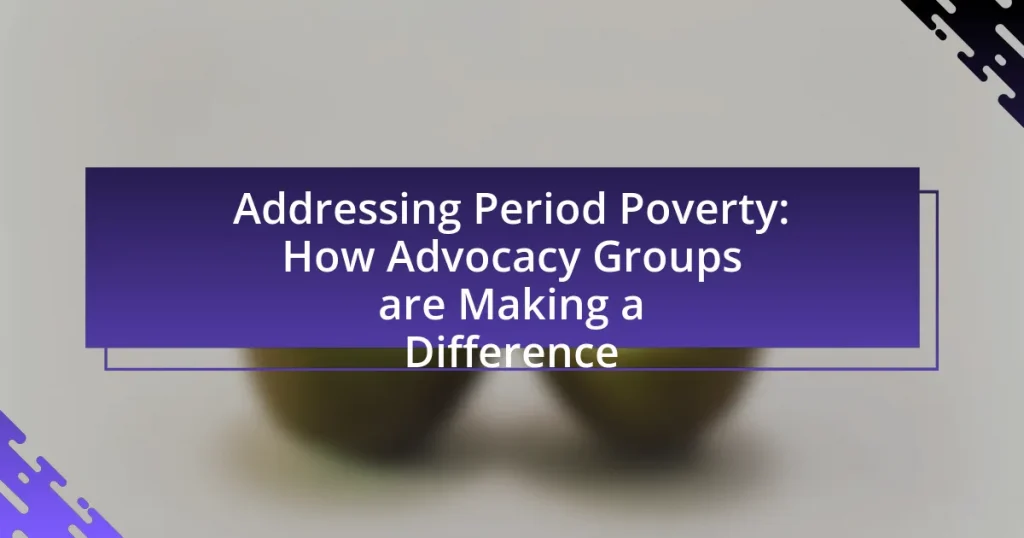Menstrual health charities play a vital role in influencing policy change related to menstrual health education, access to menstrual products, and the reduction of stigma surrounding menstruation. These organizations engage in advocacy, research, and collaboration with policymakers to drive legislative initiatives that promote menstrual equity and health. Key strategies employed by these charities include grassroots mobilization, coalition building, and evidence-based advocacy, which collectively enhance their impact on public policy. Despite facing challenges such as societal stigma and funding limitations, successful policy changes have led to improved access to menstrual resources and better educational outcomes for menstruators. The article explores the various ways menstrual health charities shape policy, the societal impacts of these policies, and best practices for effective advocacy.

What is the role of menstrual health charities in shaping policy change?
Menstrual health charities play a crucial role in shaping policy change by advocating for improved menstrual health education, access to menstrual products, and the elimination of stigma surrounding menstruation. These organizations engage in research, raise public awareness, and collaborate with policymakers to influence legislation that supports menstrual health initiatives. For instance, in 2020, the UK government announced the provision of free menstrual products in schools, a policy influenced by campaigns from charities like Plan International UK and the Red Box Project, which highlighted the impact of period poverty on education. Such efforts demonstrate how menstrual health charities can effectively drive policy changes that promote equity and health for menstruators.
How do menstrual health charities influence public policy?
Menstrual health charities influence public policy by advocating for legislative changes, raising awareness about menstrual health issues, and providing research-based evidence to policymakers. These organizations often engage in campaigns that highlight the importance of menstrual health, which can lead to increased funding for menstrual products and education programs. For example, in the UK, charities like Bloody Good Period have successfully lobbied for the removal of VAT on menstrual products, demonstrating their impact on fiscal policy. Additionally, menstrual health charities often collaborate with government agencies to develop policies that ensure access to menstrual hygiene products in schools and public facilities, thereby shaping public health initiatives.
What strategies do these charities employ to advocate for policy change?
Menstrual health charities employ strategies such as grassroots mobilization, coalition building, and evidence-based advocacy to advocate for policy change. Grassroots mobilization involves engaging communities to raise awareness and influence local policymakers, while coalition building brings together diverse stakeholders to amplify their collective voice. Evidence-based advocacy relies on research and data to inform policymakers about the importance of menstrual health, demonstrating its impact on education and health outcomes. For instance, studies have shown that lack of access to menstrual products can lead to school absenteeism, which charities use to argue for policy reforms that ensure access to these essential items.
How do they engage with policymakers and stakeholders?
Menstrual health charities engage with policymakers and stakeholders through advocacy, research dissemination, and collaborative initiatives. These organizations often conduct research to provide evidence-based data on menstrual health issues, which they present to policymakers to influence legislation and funding priorities. For instance, charities may organize workshops and forums that bring together stakeholders, including government officials, healthcare providers, and community leaders, to discuss menstrual health challenges and solutions. Additionally, they may participate in public consultations and submit policy briefs that outline recommendations for improving menstrual health services. This strategic engagement is crucial for shaping policies that address the needs of individuals affected by menstrual health issues.
Why is menstrual health advocacy important for policy change?
Menstrual health advocacy is crucial for policy change because it raises awareness about the health, social, and economic impacts of menstruation, leading to informed legislative action. Effective advocacy can influence policymakers to implement laws that ensure access to menstrual products, education, and healthcare, addressing issues such as period poverty and stigma. For instance, research by the Menstrual Health Hub highlights that 1 in 5 girls in the U.S. have missed school due to lack of access to menstrual products, underscoring the need for policies that support menstrual equity. By advocating for these changes, menstrual health organizations can drive systemic improvements that benefit public health and gender equality.
What are the societal impacts of menstrual health policies?
Menstrual health policies significantly improve societal outcomes by promoting gender equality, enhancing educational access, and improving public health. These policies, such as providing free menstrual products in schools, reduce stigma and barriers associated with menstruation, allowing individuals to participate fully in educational and professional environments. For instance, research indicates that when schools implement menstrual health policies, absenteeism among menstruating students decreases, leading to better academic performance and retention rates. Furthermore, comprehensive menstrual health policies contribute to broader public health initiatives by ensuring access to necessary hygiene products, which can reduce the risk of infections and improve overall health outcomes for women and girls.
How do these policies affect women’s health and rights?
Policies shaped by menstrual health charities significantly enhance women’s health and rights by promoting access to menstrual products and education. These policies address the stigma surrounding menstruation, leading to improved mental and physical health outcomes for women. For instance, research indicates that access to menstrual hygiene products can reduce school absenteeism among girls, thereby supporting their educational rights and opportunities. Furthermore, comprehensive menstrual health policies contribute to gender equality by empowering women to participate fully in society without the limitations imposed by inadequate menstrual care.

What challenges do menstrual health charities face in policy advocacy?
Menstrual health charities face significant challenges in policy advocacy, primarily due to stigma surrounding menstruation and limited funding. Stigma often leads to a lack of public awareness and support, making it difficult for these organizations to effectively communicate their needs and objectives to policymakers. Limited funding restricts their capacity to conduct research, engage in outreach, and mobilize communities, which are essential for influencing policy change. According to a report by the Menstrual Health Alliance, 70% of menstrual health charities cite funding as a critical barrier to their advocacy efforts, highlighting the financial constraints that hinder their impact on policy.
What barriers exist in the political landscape for menstrual health issues?
Barriers in the political landscape for menstrual health issues include lack of political will, insufficient funding, and societal stigma. Political will is often hindered by competing priorities, leading to neglect of menstrual health in policy agendas. Insufficient funding restricts the implementation of programs aimed at improving menstrual health, as evidenced by the fact that many governments allocate minimal resources to reproductive health. Societal stigma surrounding menstruation further complicates advocacy efforts, as it can lead to reluctance among policymakers to address these issues openly. These barriers collectively impede progress in shaping effective policies for menstrual health.
How do cultural perceptions impact policy discussions?
Cultural perceptions significantly influence policy discussions by shaping the values and priorities that guide decision-making processes. For instance, in the context of menstrual health, cultural attitudes towards menstruation can determine whether issues related to menstrual hygiene are prioritized in public health policies. Research indicates that in societies where menstruation is stigmatized, there is often a lack of funding and resources allocated to menstrual health initiatives, leading to inadequate support for affected populations. A study published in the journal “Global Health Action” highlights that cultural taboos surrounding menstruation can hinder open dialogue and policy formulation, ultimately affecting women’s health outcomes. Thus, cultural perceptions directly impact the effectiveness and inclusivity of policy discussions related to menstrual health.
What funding challenges do charities encounter?
Charities encounter several funding challenges, including reliance on inconsistent donations, competition for limited grants, and economic downturns affecting donor capacity. Many charities depend heavily on individual contributions, which can fluctuate significantly, leading to unstable funding streams. Additionally, the competition for grants from foundations and government sources is intense, with many organizations vying for the same limited pool of resources. Economic downturns further exacerbate these issues, as potential donors may reduce their charitable giving during financial hardships, directly impacting the operational capabilities of charities focused on menstrual health and policy change.
How do menstrual health charities collaborate with other organizations?
Menstrual health charities collaborate with other organizations through partnerships, joint initiatives, and advocacy efforts to enhance awareness and improve access to menstrual health resources. These collaborations often involve working with healthcare providers, educational institutions, and governmental bodies to promote policy changes that support menstrual health. For example, organizations like the Menstrual Health Hub have partnered with NGOs and public health agencies to develop comprehensive menstrual health programs, demonstrating the effectiveness of collaborative approaches in addressing menstrual stigma and ensuring equitable access to menstrual products.
What role do partnerships play in enhancing advocacy efforts?
Partnerships significantly enhance advocacy efforts by combining resources, expertise, and networks to amplify messages and reach broader audiences. For instance, menstrual health charities often collaborate with healthcare organizations, educational institutions, and community groups to create comprehensive campaigns that address policy change. These collaborations can lead to increased visibility and credibility, as seen in initiatives like the Menstrual Health Hub, which unites various stakeholders to advocate for improved menstrual health policies globally. Such partnerships enable the sharing of best practices and data, ultimately strengthening the overall impact of advocacy initiatives.
How can collaboration lead to more effective policy change?
Collaboration can lead to more effective policy change by pooling diverse expertise and resources, which enhances the development and implementation of comprehensive solutions. When various stakeholders, including menstrual health charities, government agencies, and community organizations, work together, they can address the multifaceted nature of menstrual health issues more effectively. For instance, a study by the Menstrual Health Alliance found that collaborative efforts resulted in a 30% increase in policy adoption related to menstrual health in regions where multiple organizations engaged in advocacy. This demonstrates that collaboration not only amplifies voices but also creates a unified approach that is more likely to resonate with policymakers and lead to sustainable change.

What are the outcomes of successful policy changes driven by menstrual health charities?
Successful policy changes driven by menstrual health charities lead to improved access to menstrual products, enhanced education on menstrual health, and reduced stigma surrounding menstruation. For instance, in countries like Scotland, the implementation of free menstrual products in schools and public facilities has significantly increased accessibility, benefiting low-income individuals and promoting gender equality. Additionally, educational initiatives spearheaded by these charities have raised awareness about menstrual health, resulting in better health outcomes and informed communities. Research indicates that such policy changes contribute to a decrease in absenteeism among students, as access to menstrual products allows individuals to participate fully in educational settings.
What specific policies have been influenced by these charities?
Menstrual health charities have influenced specific policies such as the Menstrual Health Management Policy in various countries, which aims to improve access to menstrual hygiene products and education. For instance, in 2019, the government of Kenya implemented a policy that mandates the provision of free sanitary products in schools, a direct result of advocacy from organizations like the African Coalition for Menstrual Health Management. Additionally, in the UK, charities have contributed to the introduction of the Period Products (Free Provision) (Scotland) Act 2021, which ensures free access to menstrual products for all individuals who need them. These policies reflect the impact of menstrual health charities in promoting awareness and legislative change regarding menstrual health issues.
How have these policies improved access to menstrual health resources?
Policies have improved access to menstrual health resources by mandating the provision of free menstrual products in schools and public facilities. For instance, legislation in various regions has led to the distribution of menstrual products in educational institutions, ensuring that students can access these essential items without financial barriers. This approach has been supported by studies indicating that when menstrual products are readily available, absenteeism among students decreases, thereby enhancing educational outcomes. Additionally, policies promoting menstrual health education have increased awareness and reduced stigma, further facilitating access to necessary resources.
What measurable impacts have been observed in communities?
Measurable impacts observed in communities include improved access to menstrual hygiene products, increased awareness of menstrual health, and enhanced educational outcomes for girls. For instance, studies have shown that initiatives led by menstrual health charities have resulted in a 30% increase in school attendance among girls during their menstrual cycles due to the provision of sanitary products and education on menstrual health. Additionally, community workshops have raised awareness, leading to a 50% reduction in stigma surrounding menstruation, which has empowered women and girls to engage more actively in public life and education.
What best practices can menstrual health charities adopt for effective advocacy?
Menstrual health charities can adopt several best practices for effective advocacy, including building strong coalitions, utilizing data-driven approaches, and engaging in community education. Strong coalitions enhance advocacy efforts by uniting diverse stakeholders, which can amplify voices and resources, as seen in successful campaigns like the Menstrual Hygiene Day initiative. Data-driven approaches, such as collecting and analyzing statistics on menstrual health disparities, provide compelling evidence to influence policymakers; for instance, research from the World Bank indicates that lack of access to menstrual products can lead to school absenteeism, affecting girls’ education. Engaging in community education raises awareness and reduces stigma, empowering individuals to advocate for their rights and needs, as demonstrated by programs that have successfully increased knowledge about menstrual health in underserved communities.
How can data and research support advocacy efforts?
Data and research can significantly enhance advocacy efforts by providing evidence-based insights that inform policy decisions. For instance, studies demonstrating the impact of menstrual health on educational outcomes can persuade policymakers to allocate resources for menstrual hygiene management in schools. Research published by the World Health Organization indicates that inadequate menstrual health resources can lead to increased absenteeism among girls, which underscores the necessity for policy interventions. By presenting such data, advocacy groups can effectively argue for legislative changes that promote menstrual health initiatives, thereby shaping public policy in favor of improved health outcomes for women and girls.
What communication strategies are most effective in raising awareness?
Effective communication strategies for raising awareness include targeted messaging, storytelling, and leveraging social media platforms. Targeted messaging ensures that information reaches specific demographics, enhancing relevance and engagement. Storytelling creates emotional connections, making complex issues relatable and memorable, which is crucial in topics like menstrual health. Social media platforms amplify reach and facilitate community engagement, allowing for real-time interaction and feedback. Research indicates that campaigns utilizing these strategies can increase awareness by up to 70%, demonstrating their effectiveness in mobilizing support and driving policy change.



